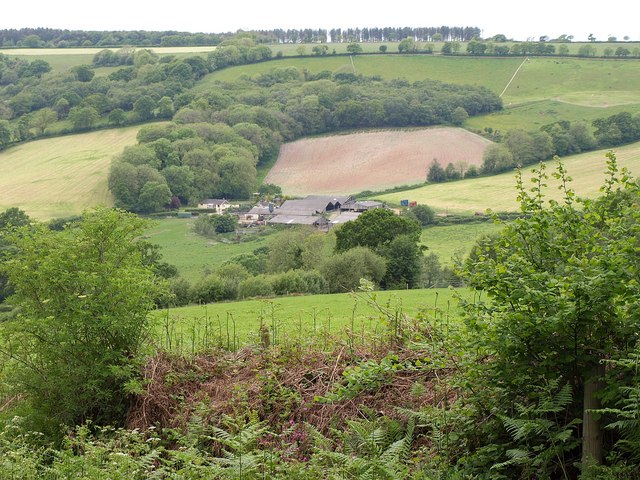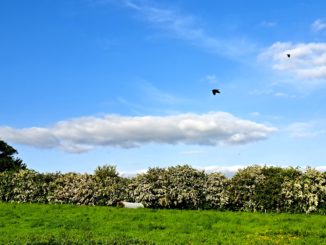
After more than 15 years living and working in Eastern Europe, the former USSR and the Middle East. Stuart Meikle returned westwards. A sabbatical followed to re-orientate himself back to North West European agriculture, food and policy issues. After the Brexit referendum, the possibilities of a UK-only policy was too interesting to pass on. A period of convalescence then allowed him the time to bring his ideas together and to write them up, thus this UK agri-food policy paper. It is an attempt to address the many relevant but complex issues at the same time. The paper was written before his soils-first policy paper published in ARC2020 (pdf) and it is best considered within the context of evolutionary thinking that is seeking to find definitive policy solutions.
Here we present number 3 of 12 policy objectives for the UK by Stuart Meikle.
A Restored Natural Environment (Key Objective 3)
The place for biodiversity is not alongside farmland; it is above it, upon it and within it. The arrival of the post-1960 agricultural ‘green’ revolution created a belief that farming could control Nature, operating best in isolation from the natural environment surrounding it. This has had negative consequences for biodiversity and soils and has left farming far from resilient.
The decline in farmland bird numbers is an example of the impact farming has had on biodiversity, and it reflects an appalling situation. It is a crisis that must be immediately and vigorously addressed. Farming must be about food production and the stewardship of the environment and our landscapes. New food and farming policy must promote a mutually beneficial approach that produces wholesome food, enhances farmland biodiversity and the wider environment while preserving Britain’s landscapes.
Biodiversity is often described as a public good and the current model of preservation means setting land aside and the taxpayer paying the farmer compensation for lost income. A radical approach is to question this whole methodology. Farming systems and biodiversity should be integrated together with the objective of enhancing the performance of both. If ‘farming for biodiversity’ is encapsulated within designated origin schemes, the consumer can then choose to reward farmers for the approach they adopt. Such schemes can be boosted by rewarding farmers for specific activities that further enhance their farms.
A key message is that biodiversity must exist across all British farmland. There are, and will always be, hot spots that warrant special attention. There is a long history in Britain of environmental land management schemes, and it is experience that must be built upon. A recent advancement is payments by results whereby the land manager is rewarded for attaining targets but given greater managerial discretion and responsibility in how to achieve those targets. It is an approach that should ensure better engagement and a diversity of management that itself should enhance the biodiversity.
There is always a danger that land designation creates detrimental focal points of land perceived to be of lower value. Whilst preserving hot spots of high-nature-value land, it is vital that ambition is not constrained to designated land. Higher nature value must be an objective for all British farmland. Likewise, whilst preserving iconic British landscapes, enhancement should be the aim for the majority.
Our landscapes are not just about aesthetics or homes for the nation’s flora and fauna. They provide the catchments for water supplies, and their management must play a core part in flood prevention for the vast numbers of British houses and businesses sited on downstream flood plains. Hence, it is imperative that any new British farming policy fully considers the multiple roles that farmers and farms play through their management of farmland. This may be by water catchment management as a public service, by safeguarding waterways from pollution, or through using potable water supplies efficiently.
It should be noted that this chapter does not go into specific detail about policies, schemes and the value of locations or landscapes. It is too complex. Here it is about setting out the general principles. That said, throughout this food, farming and rural policy paper there is a constant theme, and that is the preservation of the natural environment, prescribing measures to deal with environmental issues, and enhancing biodiversity. It is about producing both food and generating rural economic growth but it is about seeking ways in which this can be achieved in complete harmony with the natural world.
C1. FARMING IS ABOUT FOOD PRODUCTION AND LAND STEWARDSHIP
C1.1 Government to take a multiple-bottom-line approach to all of Britain’s farmed land
Farming in Britain can no longer try to operate in isolation from Nature. Several decades of attempting to do so has been to the detriment of flora and fauna and the soil and, hence, food security. Many of those years have not been good for farmer incomes or for others who worked the land. Farming and farming policy-makers face major challenges and they need to reconsider their principle objectives.
C1.2 Government to focus on integrating profitable food production and land stewardship
Food production must be profitable. Those involved need to be able to regenerate their assets, not least among which is the soil. They need to enjoy a sustainable livelihood. They need to re-establish themselves and food production as an economic force in rural communities. To achieve these goals, they will also have to sympathetically steward the land to the approval of the consumer-taxpayer, to the benefit of nature and the environment owned by all, and, finally, to their own personal advantage.
C2. RETURNING NATURE’S BIODIVERSITY TO BRITISH FARMS AND SOIL
C2.1 Government to focus support on activities that integrate biodiversity into farmlands
Often biodiversity is viewed as existing alongside farmland; that the two are incompatible. Biodiversity must exist on, above and within our farmed land and not alongside it. It requires a changed mindset.
C2.2 Government not to provide support that may promote the use of crop monocultures
There should be no direct support for crop monocultures. Farms that wish to pursue such should do so aware that their returns come from the market alone. Conversely, support should go to those who adopt holistic farming systems that fully integrate biodiversity enhancement into the farming system.
C2.3 Government to promote the reintegration of livestock into combinable-crop systems
Declining soil health, fertility and organic matters will force the return of livestock arable areas and to graze them within mixed-farming cropping rotations. There are also benefits in terms of weed (i.e. blackgrass) and disease control. Parasitic worms will be less of a problem. The return of leys to arable land will also benefit local fauna. Where grazing practices like mob grazing are used, the long between-grazings recovery-periods will specifically benefit bird life and insect life. Support must be given to recreate a livestock infrastructure and reconfigure fields for livestock management. A fair assessment of the food potential from such integrated farming systems when well-developed needs to be made.
C2.4 Government to actively support multi-enterprise silvo-pastoralism and agro-forestry
There is a growing awareness that land can be more productive when trees are integrated with grazing pastures [nuts will rise in importance as a food source]. A combination of traditional orchard trees and mob-grazing biodiverse-pastures between the rows will create a very positive environment for many species. Pigs and poultry are naturally forest creatures and raising them within a woodland/forestry environment should again be encouraged. The establishment of such systems is needed and support must be given as there will be capital costs associated with reconfiguring farms for agro-forestry and silvo-pastoralism. There may also be special equipment needed to adopt new enterprises, livestock breeds might need changing, and help given for propagating and raising both fruit and nut trees.
C3. CREATING A ‘BIODIVERSITY-FARMING’ STANDARD AND FOOD LABEL
C3.1 Government to develop a new farming standard to communicate with the consumer
The consumer-taxpayer must give clear market signals to farmer-landowners. The mechanisms must exist to allow this to happen. Hence, it is necessary to create specific product labels that indicate that the product has been produced on farms that adopt whole-farm, biodiversity-enhancing practices.
C3.2 Government to promote biodiversity-standard label(s) to distinguish British produce
High biodiversity standards must not be undermined by lower-standard imported-produce. As it is necessary to enhance biodiversity on British farmland, the British consumer must be given the choice to purchase products that support British biodiversity. A Biodiversity Standard will give the consumer the choice and highlight the availability of that choice whilst allowing free-trading markets to operate.
C4. BUILDING UPON THE COUNTRY’S LAND-STEWARDSHIP EXPERIENCE
C4.1 Government to ensure that in landscape management Britain will be a global leader
Within the EU, it is fair to say that the UK was a leader in designing and implementing agri-environment schemes. If anything, being part of a 28-member Common Agricultural Policy has held back progress. Outside the EU, Britain will have the opportunity to be a global leader in managing landscapes and the biodiversity within them. Brexit is not the chance for deregulation and joining the race to the bottom.
C4.2 Government to pledge that post-EU freedom will mean going onwards and upwards
The Government must categorically state that, upon leaving the EU, it will strive to implement the highest environmental standards. There must be no dilution of what has been achieved to date. Britain faces environmentally-related issues concerning the climate, the soil and water which are absolutely fundamental to the future of the Planet and human existence. The environment has been degraded by exploitative practices and those must end and be reversed. It is not about a vague label with the word environment upon it, it is about the well-being of the generations of humans, flora and fauna to come.
C5. CONTINUING THE DEVELOPMENT OF GOAL-DRIVEN MANAGEMENT
C5.1 Government to continue with the goal-driven environmental management approach
The UK has been evolving a goal-driven approach to managing environmental stewardship schemes. This puts the responsibility for achieving specified targets in the hands of the land manager; be they the owner, the farmer or the grower. This approach should deliver higher levels of engagement with land managers. It also links rewards to deliverables. It is the approach that should be progressed with.
C5.2 Government to ensure that landowners or farmers are the principal decision-makers
It should not be conceivable that there can be a separation of decision-making on British land holdings. It will only be possible to achieve environmental successes if landowners, farmers and growers are fully committed to managing their land to achieve the maximum environmental benefits. At the same time as striving for such a goal, they must produce food and earn themselves a reasonable income. To combine these roles requires coherent management and that must be provided by the individual(s) who are best placed to provide it. They may require advise, education and other support, but so be it.
C5.3 Government to ensure that environmental stewardship is not too highly proscriptive
Within the context of goal-driven environmental stewardship schemes, land managers must be given the freedom and flexibility to make their own decisions with respect to delivering the stated goals. It is already a part of the concept but any urges to be overly proscriptive must be resisted. Floral diversity can be at its most diverse when there is a degree of land management change year-to-year and overly proscriptive environmental management can negatively impact it. For example, proscribed hay cutting dates in meadows will favour one species over another whereas the biodiversity itself may have come about from farmers varying the mowing time year-on-year. Simply, the diversity creates biodiversity.
C6. MAINTAINING AND PRESERVING OUR ICONIC BRITISH LANDSCAPES
C6.1 Government to continue to develop the management of Britain’s iconic landscapes
Decisions over what are iconic British landscapes are beyond the remit of this paper. The detail of how they are managed from an aesthetic and environmental perspective, likewise. This paper is about food, farming and rural policy and it makes recommendations concerning the interaction between farming and the environment within which it operates. It states that food production must not be paramount, even in the face of expanding global populations, as most iconic landscapes in the UK must now play a wider and greater role. Food and farming must now develop in conjunction with the activities needed to deliver upon multiple goals and policy must be created to enable this to do so.
C7. FARMING TO ENLARGE THE UK’S HIGH-NATURE-VALUE LAND AREA
C7.1 Government to undertake a survey into the magnitude of the British HNV land area
An underlying Government policy must be to enhance the biodiversity existing above, on and within all British farmland. To create a baseline for that policy, the Government should commission a survey to record the extent of high-nature-value land across the UK. This will, of course, require the term to be clearly defined in the first instance. Such a census should, like the census of the British population happen every 10 years. It can then provide the benchmark against which progress can be measured.
C7.2 Government to focus upon enlarging the HNV land area across the United Kingdom
High-Nature-Value land must not be viewed as rare. There are other designations that can provide a clear designation for biodiversity hot-spots. Achieving HNV status for farmland must be considered as an objective by landowners, farmers and growers. Ideally, it is a term that should be incorporated into designated-origin schemes as being produce derived from the HNV land. Such an approach would link HNV land to the consumer via the product. The rewards for achieving HNV status should then come from the market place as well as from personal satisfaction and any relevant public service payments.
C8. MANAGING AGRICULTURAL LANDS WITHIN WATER CATCHMENTS
C8.1 Government to prioritise flood-water management within high-risk river catchments
Water management within British farming was discussed at greater length in Section A9 earlier. It is, however, necessary to state that in a highly-urbanised country like the United Kingdom, it is probable that flood prevention will have to take priority over food production. This will be the case in upland regions dominated by agriculturally less productive land. That said, as mentioned later, it is important that the role of the upland farmer is not forgotten; it may just have to be reconfigured. Downstream, the policy must be to restore flood plains to do what nature intended and to reinstate water meadows. It will mean a changed food production role and a focus upon flood prevention and habitat restoration.
C8.2 Government to ensure that flood prevention schemes are well combined with farming
Flood prevention can also mean employing farming practices that improve water retention. Possibly the most valuable all-around measure will be to increase the humus content of soils as soils with high organic matter levels retain greater amounts of water. Such soils should slow the speed that rainwater moves through them and, hence, slow the accumulation of flood water. The greater water retention capacity of the soil should improve crop growth and/or mitigate against drought when rainfall is scarce. In addition, high soil-humus contents would normally be an indicator of better soil health and greater fertility. Raising humus content is just one example of linking farming with water management.
C8.3 Government to take advantage of flood prevention schemes to create wetland habits
When houses and business are threatened by increasingly frequent flooding events there becomes a clear economic case for flood-prevention measures. This is likely to be a common conclusion when cost-benefit analysis is done upon new flood-prevention schemes across Britain. With the economic justification resulting from flood-prevention benefits, joining the dots would suggest that there will be opportunity to piggy-back environmental schemes onto flood prevention ones. Restoring wetland habitats and creating new ones, even at the expensive of farmland, might be the best way forwards.
C9. LINKING THE NATURAL ENVIRONMENT WITH PREMIUM MARKETS
C9.1 Government to ensure that premium food markets reward environmental restoration
Although the link between markets and the environment is not an obvious one, it is one that must be created. Markets must recognise good practices and be able to reward those who implement them. It is why so many sections within this policy paper refer to creating new designated-origin schemes.
C9.2 Government to encourage designated-origin schemes to be linked to the environment
The freedom for the Government to determine its own food, farming and environmental policies is happening at a time when the British consumer-taxpayer is becoming ever more aware of the issues. It is important that they can transmit their messages to farmers, growers and food processors. This can be done via their lobby groups but, ideally, it should happen via the market place. To enable this to occur, the Government must encourage food producers to create designated-origin schemes that highlight the environmentally-beneficial farming practices employed in the product’s creation. The consumer can then reward the producer with a purchase. They can also choose to pay a premium.
C9.3 Government to use the food market to make environmental preservation sustainable
A problem for any environmental scheme is its financial sustainability. The reality is that a scheme is only as sustainable as its funding. If this emanates from the government, it requires political support to survive. If it is charitably funding, its sustainability extends only as far as the next donation. Hence, the markets must be a main funding stream. Ideally. they should become the primary funding source. This again, requires the production and marketing of products that are linked to farming practices that are focused upon environmental preservation. Through a designated-origin scheme, the consumer can then support the scheme through a conscious and ethically-orientated purchase of the product.
C10. BRITISH FARMING WITHIN THE LARGER NATURAL ENVIRONMENT
C10.1 Government to catalogue and verify the wider environmental impacts of N-fertiliser
There are environmental and farming-input-cost benefits from reducing the artificial nitrogen use on grassland. Externalities from nitrogen use relate to, for example, removing leached [applied] nitrates from drinking water and aquifer contamination and leakage from farming usage into the atmosphere. Thus, reducing nitrogen usage on British farms was highlighted above in C8 and C9. Nitrate seepage almost certainly goes further with marine environments being contaminated. In the worst cases, dead zones are being recorded. Nitrates are, therefore not a local issue. The nitrates situation needs to be catalogued and the scale of the problem fully appreciated. Potentially it will be the next ‘plastics’ and, if so, it will impact upon modern food production systems more than any other factor in recent history.
C10.2 Government to guarantee that all agricultural plastics are biodegradable or recycled
The Government must review the usage of all plastics in food production; from farm to fork. On-farm they must ensure that plastics are fully biodegradable or recycled. Such as silage plastics are now recycled into useful, often farming and gardening-related, products. More can probably be done. The Government should encourage such and also support research into alternatives to single-use plastic.
C10.3 Government to fund research into the wide environmental impact of artificial fibres
There is a rising awareness that clothing has a massive environmental footprint with even ‘natural’ fibres like cotton being problematic; for example, the Aral Sea mega-disaster or cotton’s high pesticide use. Artificial fibres may be petrochemical [fossil-fuel] based. Clothes can be recycled in terms of use but how many are biodegradable and not destined to finish as land fill? Microfibre pollution from clothing into oceans is only now becoming recognised as a very serious problem for all marine life. It is urgent that the environmental impact of artificial fibres is fully understood and alternatives sought.
C10.4 Government to ensure that plant-based plastics come from regenerative agriculture
As fossil fuel reserves decline, the future of petrochemical-based plastics must come into question. Efforts will be made to replace them with synthetic plastics from plant sources. As such, they should also be biodegradable. A significant part of this food strategy is, nonetheless, about addressing threats to food systems through, for example, soil degradation. As with the sustainability of some biofuels, is there the capacity to extract more from our farming systems? If one considers that farm ‘wastes’ must be recycled back to the soil, the idea that plastics can be made from farm ‘waste’ [or by-products] is flawed. Hence, the Government must ensure that the raw materials come from regenerative farming.
C10.4 Government to fund research and promote the use of natural, biodegradable fibres
Historically, agriculture was the primary source of fibres, be it wool and flax for clothes or hemp for ropes. As the environmental cost of artificial fibres and some cotton production becomes more widely known, it is likely that agriculture will again be a major source of [fully and easily biodegradable] fibres. If one accepts that grazing animals are fundamental to regenerative agriculture, albeit that plant-only systems are possible, it is obvious that fleeces are a greatly under-utilised resource. Within the context of building a sustainable food system, innovations that utilise ‘pasture-derived’ fleeces must happen.
Previous chapters
UK | Chapter 2 : Minimising Net GHG Emissions from Food Systems
Book Serialisation | Creating a New British Farming Food and Rural Policy





